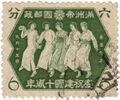خمس أعراق في اتحاد واحد (مانچوكوو)
| خمس أعراق في اتحاد واحد | |||||||||
|---|---|---|---|---|---|---|---|---|---|
 | |||||||||
| Chinese name | |||||||||
| الصينية التقليدية | 五族協和 | ||||||||
| الصينية المبسطة | 五族协和 | ||||||||
| |||||||||
| Korean name | |||||||||
| هانگول | 오족협화 | ||||||||
| هانچا | 五族協和 | ||||||||
| |||||||||
| Japanese name | |||||||||
| كانجي | 五族協和 | ||||||||
| هيراگانا | ごぞくきょうわ | ||||||||
| |||||||||
خمس أعراق في اتحاد واحد (صينية: 五族協和�, يابانية: 五族協和) was used as a national motto in Manchukuo, for the five ethnic groups of the Manchus, the Japanese, the Han Chinese, the Mongols and the Koreans. It was similar to the "Five Races Under One Union" (صينية: 五族共和) motto used by the Republic of China, for the Han, Manchus, Hui, Mongols and Tibetans, but the third of the four Chinese characters was changed from Togetherness (صينية: 共) to Cooperation (صينية: 協�). Both mottoes were pronounced the same "Go zoku kyōwa" in Japanese.
This motto was symbolized in the national flag of Manchukuo, as the yellow base color (Manchus) with four striped colors in the upper left corner: red (Japanese), blue (Han Chinese), white (Mongols) and black (Koreans).[1]
. . . . . . . . . . . . . . . . . . . . . . . . . . . . . . . . . . . . . . . . . . . . . . . . . . . . . . . . . . . . . . . . . . . . . . . . . . . . . . . . . . . . . . . . . . . . . . . . . . . . . . . . . . . . . . . . . . . . . . . . . . . . . . . . . . . . . . . . . . . . . . . . . . . . . . . . . . . . . . . . . . . . . . . .
معرض
Manchuria Aviation Company roundel, 1931–1945
War ensign of مانچوكوو, 1932–1945
جيش مانچوكوو insignia, 1932–1945
Manchukuo Air Force roundel, 1937–1945
Central Bank of Manchou 1 yuan banknote, 1932
Commemorative stamp propagating the "Concord of Nationalities"
"مع تعاون اليابان والصين ومانچوكوو العالم يمكنه أن يكون في سلام"، 1935
پروپاگندا لحكومة جنوب تشاهار الذاتية، ح. 1937–1939







